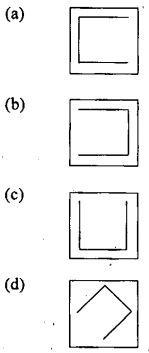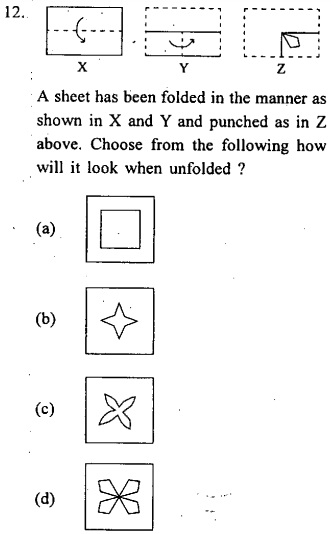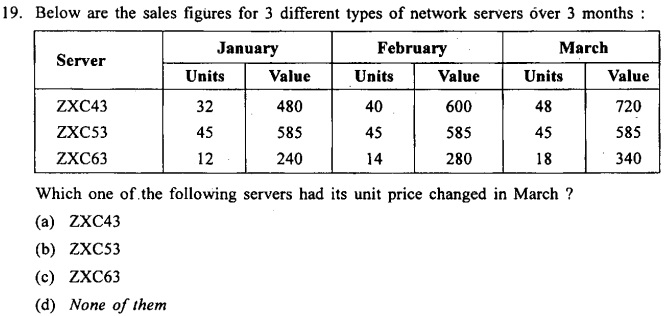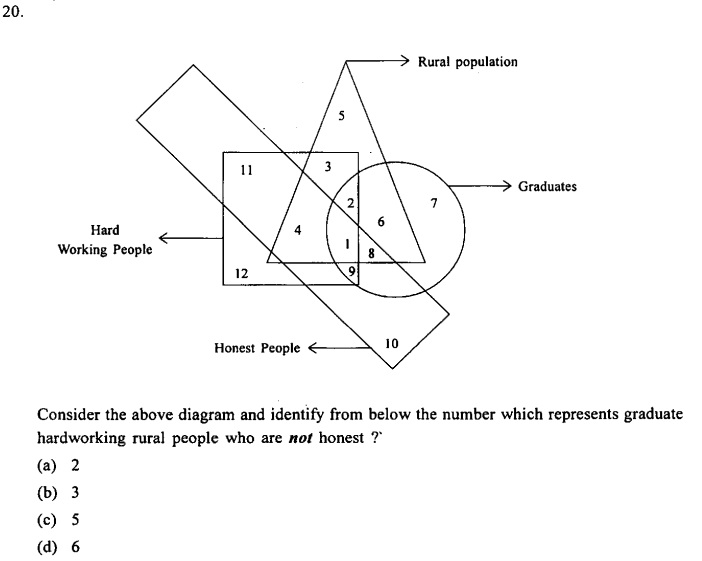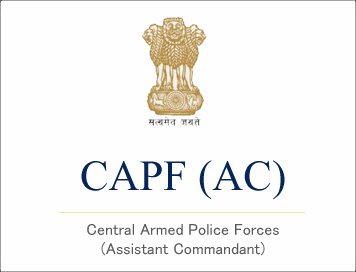
(Download) CAPF (AC) Exam, 2014 Paper - "General Ability &
Intelligence"
Exam Name: Central Police Force (Assistant Commandant) Exam
Subject: General Ability and Intelligence
Paper: I
Year: 2014
Size : 1.42 MB
File Type: PDF
Directions (1-7): The following items consists of two Statements I and II.
You are to examine these two statements carefully and select the answer to these
items using the code given below.
Codes
(a) Both the statements are individually true and Statement II is the correct
explanation of Statement I
(b) Both the statements are individually true but Statement II is not the
correct explanation of Statement I
(c) Statement I is true and Statement II is false
(d) Statement I is false but Statement II is true
1. Statements
I. The Rajya Sabha is not subject to dissolution and the members enjoy a
tenure of six years.
II. According to Article 83 of the Constitution of India, one-third of members
of Rajya Sabha retire every two years.
2. Statements
I. Impeachment procedure is a quasi-judicial procedure and the President of
India can be impeached only on the grounds of violation of the Constitution.
II. The impeachment procedure can be initiated in either House of the
Parliament.
3. Statements
I. James Prinsep, an officer in the mint of the East India Company,
deciphered Brahmi and Kharosthi scripts which were used in the earliest
inscriptions and coins.
II. James Prinsep found that most of the scripts mentioned a king referred to as
Piyadassi Meaning 'pleasant to behold'.
4. Statements
I. The rich sculptural tradition of Mathura is distinguished by its principal
medium, the white spotted red sandstone.
II. The white spotted red sandstone is locally available in Mathura region.
5. Statements
I. The cities of the second urbanization in Indian history are mainly located
in the Ganga valley.
II. Advanced iron technology, ensuring an agrarian surplus is instrumental to
this process of urbanization.
6. Statements
I. The Doldrums is a low pressure area around the Equator where the
prevailing winds are calm.
II. Low pressure is caused by the heat at the Equator which makes the air rise
and travel both Northwards and Southwards.
7. Statements
I. Roaring Forties are strong Westerly winds found in the Southern
Hemisphere, generally between the latitudes of 40° and 50°.
II. The strong East to West air currents are caused by the combination of air
being' displaced from the Equator towards the South Pole and the Earth's
rotation and there are few landmasses to serve as wind breaks.
8. Which one of the following statements with regard to the revised
ceiling' on poll expenditure for elections in India is correct?
(a) Rs. 40 lakh per candidate for all Lok Sabha as well as Assembly
Constituencies
(b) Rs. 70 lakh per candidate for all Lok Sabha Constituencies
(c) Rs. 70 lakh per candidate for Lok Sabha Constituencies for all states except
Arunachal Pradesh. Goa and Sikkim
(d) Rs. 70 lakh per' candidate for Lok Sabha Constituencies for all states
except Union Territories.
9. Which of the following does not relate to the Fundamental Rights as
enshrined in the Constitution of India?
1. Free and compulsory education to all children of the 'age of 6-14 yr.
2. Prohibition of trafficking in human beings and
3. Improvement of Public health and prohibition of intoxicating drinks.
4. Promotion of the educational and economic interests of the weaker sections of
the people, especially the Scheduled Castes and Scheduled Tribes.
Select the correct answer using the codes given below.
Codes
(a) 1 and 2
(b) 2 and 4
(c) Only 3
(d) 3 and 4
10. Which one among the following regarding the Ahadis of the Mughal
period is not true?
(a) They were individual troopers
(b) They were placed under a separate Diwan and Bakhshi
(c) They were ordinarily not placed under the Mansabdars
(d) Their salary was at par with the Mansabdars
11. Consider the following.
In March 2014 mortal remains of a number of Indian soldiers of 1857 mutiny
were exhumed from a well at ………. These mortal remains are of ……. Who revolted
against the British.
Complete the statements with appropriate information.
(a) Jallianwala Bagh, 36 Regiment of Sikh Infantry
(b) Lahore, 75 Regular Native Infantry Regiment
(c) Ajnala, 26 Regiment of Bengal Native Infantry
(d) Satti Chaura Ghat, 19 Regiment of Bengal Native Infantry
12. When a, fall in price of a commodity reduces total expenditure and a
rise in price increases it, price elasticity of demand will be
(a) l
(b) < 1
(c) > 1
(d) Infinity
13. Which one among the following cannot be attributed to Shah Jahan's
reign?
(a) Moti Masjid
(b) Qila-i-Kuhna Masjid
(c) Jama Masjid
(d) Ring Mahal
14. The historical drama film '12 Years a Slave' which was adjudged best
picture at 86th Academy Awards presented in March 2014, is based on 1853 memoir
of the same name by
(a) Steve McQueen
(b) Solomon Northup
(c) Brad Pitt
(d) Matthew McConaughey
15. Which of the following are true regarding the Preamble of the
Constitution of India?
1. The Objective Resolution was proposed by Jawaharlal Nehru and passed by
the Constituent Assembly which ultimately 15ecame the preamble.
2. The idea of the preamble was borrowed from the Constitution of USA.
3. The words Socialist and Secular were adopted by the 42nd, Amendment in 1976.
4. The preamble, incorporates the Fundamental Rights of the citizens of India,
Select the correct answer using the codes given below.
Codes
(a) 1, 2 and 3
(b) 2, 3 and 4
(c) 1, 3 and 4
(d) 1, 2 and 4
16. Which one among the following is not true of bead making as a salient
feature of mature Harappan crafts?
(a) Harappan beads were made of gold, copper,shell, lapis lazuli, ivory and a
variety of semi precious stones
(b) Archaeologists have identified bead-makers shops on the basis of
assernblaqes of - unfinished objects
(c) At Chanhudaro, tools, furnaces and beads in various stages of preparations
have been found
(d) The structure of Banawali, yielded many beads in finished, semi-finished and
unfinished states
17. The leader of which one .of the following countries has recently
executed his deputy who happened to be his own uncle?
(a) South Sudan
(b) Syria
(c) Myanmar
(d) North Korea
18. Which of the following statement is true?
(a) The Panchayat system exists in all states of India except Nagaland,
Meghalaya and Mizoram. It also exists in all Union Territories except Delhi
(b) The Panchayat system is introduced in India by the Constitution 74th
Amendment Act and envisages a three tier system of Local Governance
(c) Panchayat system is not provided for states having less than 2 million
population
(d) Gram Panchayat can continue for 3 years from the date of election .
19. Composition of the biography of the Buddha occupies a special place in
Buddhist literature. Which one among the following is a full-fledged biography
of the Buddha?
(a) Lalitavistara
(b) Milind Panho
(c) Sariputra-prakarana
(d) Avadanasataka
20. Which one among the following statements about the GSLV-D5 launched by
India on 5th January, 2014 is not true?
(a) It puts India in an elite club with Russia, USA,China, Japan and France
(b) It uses an indigenously built cryogenic engine
(c) It can place communication satellites into orbit without depending on any
other country
(d) It placed INSAT-14 precisely into its orbit
21. Which of the following is/are true regarding Urban Local Bodies in
India?
1. The Constitution 74th Amendment Act envisages three types of urban local
bodies, namely Municipal Corporation, Municipality and City Council.
2. 'Municipal Corporations are established in cities with population greater
than 1 million.
3. Bombay and Calcutta Corporations were the first Municipal Corporations that
were established during British time.
Select the correct answer using the codes given below.
Codes
(a) 1 and 2
(b) Only 2
(c) 1 and 3
(d) 1, 2 and 3
22. The Assam, Company, consisting of European tea planters, remained the
virtual proprietor of the tea industry till 1850. In the 1850s who among the
following established two small proprietary tea gardens of his own, which were
confiscated by the state after his execution for treason in 1858?
(a) Anandaram Dhekial Phukan
(b) Gunabhiram Barua
(c) Lakhinath Bezbarua
(d) Maniram Dewan
23. Which one among the following teams did not top in their respective
groups in the 2013-2014 Ranji Trophy League Table?
(a) Karnataka
(b) Punjab
(c) Railways
(d) Maharashtra
24. Which of the following statements are correct regarding the election
of the President of India?
1. He is elected indirectly.
2. He is elected through an electoral college consisting of all elected MPs and
MLAs.
3. He is elected directly.
4. Members of the Legislative Council have no right to vote in the Presidential
election.
Select the correct answer using the codes given below.
Codes
(a) 1 and 2
(b) 1, 2 and 4
(c) 1 and 4
(d) 3 and 4
25. Dinabandhu Mitra published a play in Bengali titled --- Neel Darpan
(Blue Mirror), which depicted the atrocities on the indigo planters. The play
was translated into English by
(a) Reverend James Long
(b) Dwarkanath Tagore
(c) Michael Madhusudan Dutta
(d) Rabindranath Tagore
26. Consider the following statements.
1. The Presidency of the Council of European Union rotates among the Member
States every six months.
2. Italy became the President of the European Union for six months since 1
January, 2014. \
Which of the statements given above is/are correct?
(a) Only 1
(b) Only 2
(c) Both 1 and 2
(d) Neither 1 nor 2
27. Which of the following are related to Right to Equality under the
provisions of Articles 14-18 of the Constitution of India?
1. Prohibition of discrimination on grounds of religion, race, caste, sex or
place of birth.
2. Equality of opportunity in matters of public employment.
3. Educational and cultural rights to minorities.
4. Abolition' of untouchability.
Select the correct answer using the codes given below.
Codes
(a) 1,2 and 3
(b) 3 and 4
(c) 1,2 and 4
(d) 1 and 2
28. Which of the following statement is/are correct?
1. Humayun invented Taj-i-izzat.
2. Taj-i-izzat was ahead gear, composed of a cap and a wrapping cloth.
Select the correct answer using the codes given below.
Codes
(a) Only 1
(b) Only 2
(c) Both 1 and 2
(d) Neither 1 nor 2
29. Which of the statements given below is/are correct?
1. For the marketing year 2014-2015, the Minimum Support Price (MSP) for
wheat in India has been fixed at t 1400 per quintal.
2. MSP is the rate at which the government sells the grains through the fair
price shops.
Select the correct answer using the codes given below.
Codes
(a) Only 1
(b) Only 2
(c) Both 1 and 2
(d) Neither 1 nor 2
30. Which of the following is/are correct regarding the office of Governor
in India? '.
1. One Governor can act as Governor of more than one state.
2. The Governor has the power to grant pardons,reprieves, remission of
punishment to persons convicted under the State Law.
3. The Governor is appointed by the President on' the recommendation of the
Chief Minister of the respective state.
Select the correct answer using the codes given below.
Codes
(a) 1 and 2
(b) 1, 2 and 3
(c) 2 and 3
(d) Only 1
31. Which one among the following was/were the motive/motives behind
Muhammad Bin Tughlaq's transfer of capital from Delhi to Daulatabad?
1. The shift to Daulatabad would give him a chance to establish control over
Deccan and Gujarat.
2. It would provide access to the Western and Southern ports.
3. It would protect him from direct Mongol invasion from the North-Western
frontier.
Select the correct answer using the codes given below.
Codes
(a) 1 and 2
(b) 2 and 3
(c) 1 and 3
(d) 1, 2 and 3
32. The Economic Advisory Council to the Prime Minister (PMEAC) in India
has recommended phased dilution of Government stake in Public Sector Banks from
(a) 74% to 56%
(b) 58% to 51%
(c) 58% to 49%
(d) 51% to 49%
33. The major cleavage in global human rights discourse has been between
(a) religious rights vs. civil rights
(b) national rights vs. minority rights
(c) gender rights vs. equal rights
(d) civil and political rights vs. economic, social and cultural rights
34. Which one among the following is not true of the Brahmo Samaj?
(a) It considered Vedic scriptures as infallible'
(b) It opposed idolatry
(c) It emphasized the worship of one God
(d) It emphasized the worship of God without the mediation of priests
35. Which of the statements given below is/are correct?
1. In India, the provisions of General Anti Avoidance Rule (GAAR) will be
implemented with effect from 1 April, 2015.
2. The provision Of GAAR were aimed at checking tax avoidance by overseas
investors.
Select the correct answer using the codes given below.
Codes
(a) Only 1
(b) Only 2
(c) Both 1 and 2
(d) Neither 1 nor 2
36. The rate at which the consumer is willing to substitute one good for
another without changing the level of satisfaction is known as
(a) marginal rate of substitution
(b) marginal rate of technical substitution
(c) diminishing marginal utility
(d) equi-marginal utility
37. Which one among the following is not true of the Theosophical Society
of Madame H P Blavatsky?
(a) It was founded outside India
(b) It advocated the revival of ancient religions 34 Assistant Commandant (CPF)
Exam Solved Paper
(c) It recognized the doctrine of transmigration of soul
(d) It was silent on the idea of Universal Brotherhood
38. Recently a leading public sector bank of India has allowed, withdrawal
of upto (1000 from any shop/trader with a Point of }sale (PoS) terminal.
Identify the bank from below.
(a) Bank of Maharashtra
(b) Punjab National Bank
(c) State Bank of India
(d) Bank of Baroda
39. The issue whether a commitment made by a Minister on the floor of the
House has been fulfilled or not is decided by the
(a) Concerned Departmentally Related Committee
(b) Business Advisory Committee
(c) Committee on Public Assurances
(d) Political Affairs Committee. of the Union Cabinet
40. Which one among the following was not a provision of the Regulating
Act of 1773?
(a) It introduced parliamentary supervision over the East India Company
(b) The Government of Bengal was vested in a Governor General and the Council of
four members
(c) It changed the power of vote in the Court of Proprietors by removing all
restrictions on qualifications
(d) The Governor-General was vested with a casting vote
41. Recently Iran has clinched a deal with six world powers to curb
nuclear activities. Which one among the following is not a party to it?
(a) USA
(b) France
(c) Russia
(d) Japan
42. Which of the following statements related to Money Bills is not
correct?
(a) It cannot be introduced in the Council of States
(b) If any question arises whether the Bill is Money Bill or not, the decision
of the Speaker is final
(c) In case of deadlock over a Money Bill, the President can summon a joint
sitting of the Parliament
(d) A Money Bill cannot be introduced except on the recommendation of the
President
43. Which one among the following explains the meaning of the 'Safety
Valve Theory' in the context of Indian National Movement?
(a) A theory that argued that the Congress was formed as a safe outlet to the
discontented educated Indians
(b) A theory that argued that the Congress was formed as a safe outlet to the
hostile attitude of the British towards the Indian people
(c) A theory which believed that the British and the ex-rebels of 1857 should
amicably resolve their differences against each other
(d) As idea aimed at promoting goodwill among the Indian people
44. As per the latest trade agreement in Bali Ministerial Conference of
WTO, India and other developing and under developed countries can launch food
security programmes.
(a) forever without any penalty under WTO rules
(b) till an alternative mechanism is developed
(c) for four calendar years
(d) only if subsidy component under such programs is less than 10%
45. Which of the following statements rewarding the residuary powers under
the Constitution of India is/ are correct?
1. Residuary powers have been given to the Union Parliament.
2. In the matter of residuary power, the Constitution of India follows the
Constitution of Australia.
3. Schedule 7 of the Constitution of India provides a list of residuary powers.
4. The Government of India Act, 1935 placed residuary powers in the hands of the
Governor - General,
Select the correct answer using the codes given below.
Codes
(a) 1 and 3
(b) 2 and 3
(c) 1 and 4
(d) Only 4
46. The Deccan Riots Commission was concerned With
(a) indebtedness of the peasant
(b) lack of law and order in the Deccan
(c) problems with the Ryotwari system
(d) communal riots in the Deccan
47. Which of the following statements about Vijay Seshadri is/are correct?
1. He is an India born US poet.
2. He won the prestigious Pulitzer Prize in the year 2014 for his book '3
Sections'.
3. He is the first Indian origin person to bag the Pulitzer Prize.
Select the correct answer using the codes given below.
Codes
(a) Only 1
(b) 1 and 2
(c) 2 and 3
(d) 1, 2 and 3
48. Which of the following is not a characteristic of globalization?
(a) Fragility of national barriers for the flow of capital and goods
(b) Rapid flow of information, capital and goods
(c) Networking of cultural, economic and political relations
(d) Global infrastructure of formal and informal institutional arrangements
49. William James, Henry Colebrooke and Nathaniel Halhed had which of the
following common among them?
(a) They were critics of Indian culture and civilization
(b) They were judges at the courts of the East India Company
(c) They were professors teaching' history and society of South Asia
(d) They were linguists who tried to interpret the culture of South Asia to the
East India Company
50. Data presented in Interim Budget for 2014-2015 reveal that for the
financial year 2013-2014, the revised estimates do not show a decline in
(a) Revenue deficit
(b) Effective revenue deficit
(c) Fiscal deficit
(d) Primary deficit
51. Which of the following statements about Presidential system is/are
correct?
1. The Head of Government is also Head of State.
2. The Executive can veto Legislative acts.
Select the correct answer using the codes given below.
Codes
(a) Only 1
(b) Only 2
(c) Both 1 and 2
(d) Neither 1 nor 2
52. The permanent settlement was rarely extended to other regions because
(a) increases in agricultural prices after 1810 increased the value of the
harvest while the permanent settlement disallowed an increases in the State's
share
(b) the economic theories of Ricardo influenced the policy makers
(c) the state found it expedient to settle directly with the ryot
(d) All of the above
53. Who among the following is serving as the Chief Minister of his State
for the fourth consecutive term?
(a) Manik Sarkar of Tripura
(b) Tarun Gogoi of Asom
(c) Neiphiu Rio of Nagaland
(d) Okram Ibobi Singh of Manipur
54. Consider the following statements about Constitutional Government.
1. It is a form of limited government.
2. One where Constitution is the basis of public authority.
3. One where Monarch is the formal head of the state.
4. One where there is always universal adult franchise.
Which of the statement given above are correct?
(a) 1 and 2
(b) 2 and 4
(c) 1, 2 and 4
(d) 1 and 3
55. The ruling dynasties Sangama, Saluva, Tuluva were associated with
(a) Warangal
(b) Kashmir
(c) Bengal
(d) Vijayanagara
56. India has made a Polio Vaccination Certificate mandatory for Indian
Visa applicants from
(a) Bangladesh
(b) China
(c) Indonesia
(d) Pakistan
57. The Ex-Officio Members of the National Human Rights Commission of
India include
(a) Chairpersons of National Commission for Minorities, National for
Scheduled castes, National commission for scheduled tribes,National commission
for Women
(b) Chairperson of national commission for minorities, National Commission for
scheduled castes, national commission for scheduled tribes only
(c) Chairpersons of National commission for scheduled castes, National
commission for scheduled tribes, National commission for women only
(d) Chairpersons of national commission for minorities, National Commission for
Scheduled Castes, National Commission for scheduled tribes, National Commission
for Protection of Child Rights
58. Between the 15th August, 1947 when India became free and the 26th
January, 1950 when she declared herself a democratic sovereign republic, the
Government of India functioned under the provision of
(a) The Government of India Act, 1935
(b) The Indian Independence Act, 1947
(c) The Indian (Provisional Constitution) Order, 1947
(d) None of the above
59. The January 2014 reference held in Egypt was on
(a) accepting or rejecting a draft Constitution
(b) choosing between democracy and Islamic rule
(c) choosing between direct and indirect election of the President
(d) choosing between two party and multi-party democracy
60. Which of the following factors affects individual's demand for a
commodity?
1. Price of the commodity
2. Income of the consumer
3. Prices of related goods
Select the correct answer using the codes given below.
Code
(a) 1 and 2
(b) 2 and 3
(c) 1, 2 and 3
(d) Only 1
61. One the New Year day of 2014, New Zealand batsman Corey Anderson made
a world record of fastest
(a) Test century
(b) Test fifty
(c) ODI century
(d) ODI Fifty
62. Match List I with List II and select the correct answer using the
codes given below the lists.
List I
(Social Activist)
A. Aruna Roy
B. Kalpana Rai
C. Akhil Gogoi Samiti
D. Pratibha Shinde
List II
(Activity/Organisation)
1. Lok Sangharsh Morcha
2. Mazdoor Kisan Salunkhe Shakti Sangathan
3. Krishak Mukti Sangram
4. Paani Panchayat
Code
A B C D
(a) 4 3 4 1
(b) 2 4 3 1
(c) 1 4 3 2
(d) 1 3 4 2
63. Which one among the following books is not written by Bharat Ratna
Prof. CNR Rao?
(a) Climbing the limit ladder - A life in Chemistry
(b) Nanocrystals - Synthesis, Properties and Applications
(c) Wings of Fire
(d) Superconductivity Today
64. What was the name given to the Indian Air Force's first ever
'day-night full combat and fire demonstration' conducted recently at the Pokhran
range? .
(a) INDRA
(b) Exercise Malabar
(c) Yudh Abhyas
(d) Iron Fist
65. The Perform Achieve and Trade (PAT) scheme in India is related to
(a) Education
(b) Global Warming
(c) Energy Efficiency
(d) Bharat Nirman




